Douglas SLV-2 Thor / Boeing (McDonnell Douglas) SB-3 Delta
The Thor launch vehicle, and the Delta derivatives thereof, traces its ancestry back to the SM-75/PGM-17 Thor intermediate range missile built by the Douglas Aircraft Corp. for the US Air Force. In April 1967 Douglas merged with McDonnell to become McDonnell Douglas, a company which was taken over by Boeing in August 1997.
The basic Thor vehicle was combined with various upper stages to produce a number of variants:
a. the Thor Able and further derivatives;
b. the Thor Agena and further derivatives;
c. the Thor Delta, now more commonly known as Delta; and
d. minor other variants.
The Thor-Delta family of launch vehicles has been subject of a variety of designations, both civilian and military. In addition to the military missile designations, as described separately for PGM-17, the basic Thor first stage received military designations in the LV/SLV whilst the Delta received designations in the SB series. The following table lists the known designations and the cross references to the launch vehicle types, however, there remain discrepancies in this list. It is probable that these designations were only used for flights carrying military satellites.
| Designation | Type |
|---|---|
| SLV-2 | Basic Thor first stage |
| SLV-2A | TAT first stage for Agena B and D upper stage |
| SLV-2B | ?? |
| SLV-2C | TAT first stage for Agena B and D upper stage |
| SLV-2D | Thor first stage on Asset flights |
| LV-2C | Thor first stage for Delta upper stage on Asset flights |
| LV-2D | Thor first stage for Altair (Burner I) upper stage |
| SLV-2E | ?? |
| LV-2F | Thor first stage for Burner II upper stage |
| SLV-2F | Thor first stage for Burner II upper stage |
| SLV-2G | LTTAT (Thorad) first stage (DSV-2L) for Agena upper stage |
| SLV-2H | LTTAT (Thorad) first stage (DSV-2L-1A) for Agena upper stage |
| SLV-2J | LTTAT for Delta upper stage (DSV-3L) |
| SLV-2K | LTTAT for Delta upper stage; for 3, 6 or 9 boosters (DSV-3N) |
| SB-3A | Delta II |
Initially the civilian designations included DM (probably meaning Douglas Missile) and DSV (probably meaning Douglas Space Vehicle), as described with the individual launch vehicles. The post 1971 designations systems have been discussed later.
Individual vehicles have a number of designations. The basic Thor missiles had an individual three digit number commencing with 101. In addition these had a military serial. With the introduction of the Thor Delta a new series was started with 1.
Thor
The first successful flight of a Thor missile took place on 20 September 1957 and 69 flights have been documented. The basic Thor missile (also identified as DM-18) was never used for space launches but was used for 34 launched in sub-orbital programmes of a scientific and technological nature. There were eight launches in the Dominic programme between 2 May 1962 and 1 November 1962. These launches were conducted from Johnstone Island. Also flown from Johnstone Island were 13 Antisatellite tests between 14 February 1964 and 12 November 1968. Six flights from Cape Canaveral in the Asset programme were conducted between 18 September 1963 and 23 February 1965. Some of the Asset programme flights have also been identified as Thor LV-2C Delta.
| Stage | Length | Diameter | Engine | Fuel | Thrust |
|---|---|---|---|---|---|
| 1 | 18.40 m | 2.44 m | 1 Rocketdyne LR79-NA-7 | Lox/kerosene | 758,738 N |
Specifications for Thor
Thor Able
The Thor Able combination consisted of the basic Thor missile, which was propelled by a Rocketdyne MB-3-I motor, and the Able two-stage vehicle which was built by Space General and was originally used for the Vanguard launch vehicle. It appeared in various configurations. The Thor Able combination had a length of up to 27.40 m and was capable of launching a 114 kg payload into a low-Earth orbit.
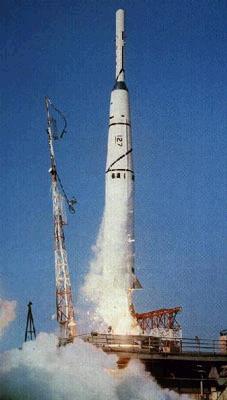 |
| Photo: USAF via Mark Wade |
| Thor Able |
The Thor Able I version was used for six launched between 23 April 1958 and 7 November 1958. Three of these were sub-orbital, whilst three were space launches of which one failed.
| Stage | Length | Diameter | Engine | Fuel | Thrust |
|---|---|---|---|---|---|
| 1 | 18.40 m | 2.44 m | 1 Rocketdyne MB-3-I | Lox/kerosene | 666,875 N |
| 2 | 6.60 m | 0.80 m | 1 Aerojet AJ-10-41 | N2O4/UDMH | 33,345 N |
| 3 | 1.80 m | 0.46 m | 1 ABL X-248-A3 Altair | solid | 13,340 N |
Specifications for Thor Able I
With a first launch on 23 January 1959, the Thor Able II was used eight times until 1 April 1960. Six of these were sub-orbital and two were space launches, of which one failed. This version had no third stage.
| Stage | Length | Diameter | Engine | Fuel | Thrust |
|---|---|---|---|---|---|
| 1 | 18.40 m | 2.44 m | 1 Rocketdyne MB-3-I | Lox/kerosene | 666,875 N |
| 2 | 6.60 m | 0.80 m | 1 Aerojet AJ-10-42 | N2O4/UDMH | 33,345 N |
Specifications for Thor Able II
Only one example of the Thor Able III version was flown on 7 August 1959.
| Stage | Length | Diameter | Engine | Fuel | Thrust |
|---|---|---|---|---|---|
| 1 | 18.40 m | 2.44 m | 1 Rocketdyne MB-3-I | Lox/kerosene | 666,875 N |
| 2 | 6.60 m | 0.80 m | 1 Aerojet AJ-101A | N2O4/UDMH | 33,345 N |
| 3 | 1.80 m | 0.46 m | 1 ABL X-248-A4 Altair | solid | 13,340 N |
| 4 | ? | ? | 1 Atlantic 1KS420 | solid | 1,776 N |
Specifications for Thor Able III
The only Thor Able IV flight took place on 11 March 1960.
| Stage | Length | Diameter | Engine | Fuel | Thrust |
|---|---|---|---|---|---|
| 1 | 18.40 m | 2.44 m | 1 Rocketdyne MB-3-I | Lox/kerosene | 666,875 N |
| 2 | 6.60 m | 0.80 m | 1 Aerojet AJ-10-42 | N2O4/UDMH | 33,345 N |
| 3 | 1.80 m | 0.46 m | 1 ABL X-248-A4 Altair | solid | 13,340 N |
Specifications for Thor Able IV
Thor Ablestar
The Thor Ablestar, initially known as Thor Epsilon, combined an improved basic Thor vehicle, designated as DM-21, with a new second stage based on the Able and built by Space General, giving it a total length of 23.77 m. The vehicle was also identified as DSV-2A and DSV-6.
 |
| Photo: Author's collection |
| Thor Ablestar |
| Stage | Length | Diameter | Engine | Fuel | Thrust |
|---|---|---|---|---|---|
| 1 | 18.40 m | 2.44 m | 1 Rocketdyne MB-3-II | Lox/kerosene | 756,120 N |
| 2 | 5.90 m | 1.40 m | 1 Aerojet AJ-10-104 | N2O4/UDMH | 35,090 N |
Specifications for Thor Ablestar
The combination had an orbiting capability of 270 kg into low-Earth orbit and was used between 13 April 1960 and 13 August 1965 for 19 flights of which five failed.
Thor Agena
Originally known as Hustler after the Bell motor, the Agena upper stage was developed by Lockheed and had a Bell liquid fuelled motor (for more details refer RM-81). It was fitted with the basic Thor first stage to create the Thor Agena A, Thor Agena B and Thor Agena D combinations, whilst the upper stage was also combined with improved developments of the Thor first stage, resulting in the TAT Agena B, TAT Agena D and Thorad Agena D versions.
The Thor Agena A version used the DM-18A first stage and had a length of 23.90 m. It was capable of placing payloads of up to 770 kg into low-Earth orbit. It was used between 21 January 1959 and 13 September 1960 for 16 flights of which six failed.
| Stage | Length | Diameter | Engine | Fuel | Thrust |
|---|---|---|---|---|---|
| 1 | 18.40 m | 2.44 m | 1 Rocketdyne MB-3-I | Lox/kerosene | 666,875 N |
| 2 | 4.70 m | 1.50 m | 1 Bell LR81-BA-5 | N2O4/UDMH | 68,953 N |
Specifications for Thor Agena A
The Thor Agena B used the DM-21 first stage version with an improved upper stage which incorporated a re-start capability. This gave the launch vehicle an orbiting capability of 950 kg into low-Earth orbit. The 24.80 m launch vehicle was used for 47 launches between 26 October 1960 and 29 November 1965. Nine of these failed.
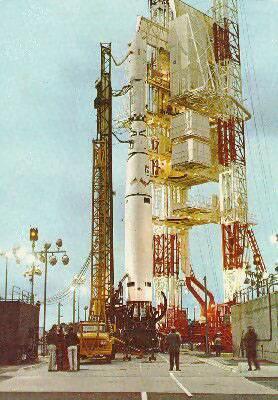 |
| Photo: Author's collection |
| Thor Agena B |
| Stage | Length | Diameter | Engine | Fuel | Thrust |
|---|---|---|---|---|---|
| 1 | 18.40 m | 2.44 m | 1 Rocketdyne MB-3-II | Lox/kerosene | 756,120 N |
| 2 | 7.10 m | 1.50 m | 1 Bell 8081 | N2O4/UDMH | 71,169 N |
Specifications for Thor Agena B
The Thor Agena D combination used an improved first stage identified as DSV-2A as well as an improved upper stage. Being capable of placing 1150 kg into low-Earth orbit, the launch vehicle was used between 2 August 1962 and 20 May 1970. Of the 20 flights, three failed. The entire Thor Agena D combination had a length of 23.25 m.
| Stage | Length | Diameter | Engine | Fuel | Thrust |
|---|---|---|---|---|---|
| 1 | 18.40 m | 2.44 m | 1 Rocketdyne MB-3-II | Lox/kerosene | 756,120 N |
| 2 | 7.10 m | 1.50 m | 1 Bell 8096 | N2O4/UDMH | 71,199 N |
Specifications for Thor Agena D
The Agena B and D upper stages was also combined with the Thrust Augmented (TAT) first stage, which consisted of the basic Thor vehicle with three strap-on solid fuelled boosters. The first stage was also identified as DSV-2C. The resulting TAT Agena B had a length of up to 31 m and an orbiting capability of app. 1000 kg into low-Earth orbit and was used on only two flights on 29 June 1963 and 16 May 1966.
| Stage | Length | Diameter | Engine | Fuel | Thrust |
|---|---|---|---|---|---|
| 0 | --- | --- | 3 Thiokol Castor TX-345-5 | solid | 286,217 N each |
| 1 | 18.40 m | 2.44 m | 1 Rocketdyne MB-3-III | Lox/kerosene | 866,742 N |
| 2 | 7.10 m | 1.50 m | 1 Bell 8081 | N2O4/UDMH | 71,169 N |
Specifications for TAT Agena B
The TAT Agena D version was much more extensively used. Of the 65 flights between 28 February 1963 and 4 February 1970 only four failed. The up to 31 m long vehicle could place 1130 kg payloads into low-Earth orbit.
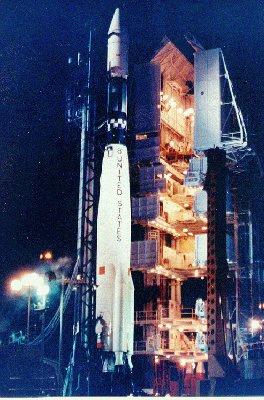 |
| Photo: USAF via Mark Wade |
| TAT Agena D |
| Stage | Length | Diameter | Engine | Fuel | Thrust |
|---|---|---|---|---|---|
| 0 | --- | --- | 3 Thiokol Castor TX-345-5 | solid | 286,217 N each |
| 1 | 18.40 m | 2.44 m | 1 Rocketdyne MB-3-III | Lox/kerosene | 866,742 N |
| 2 | 7.10 m | 1.50 m | 1 Bell 8096 | N2O4/UDMH | 71,199 N |
Specifications for TAT Agena D
The final version of the Thor combined an Agena D upper stage with the DSV-2L long tank first stage with either three, six or nine solid fuelled strap on boosters. The combination has been referred to as Thorad Agena D or Long Tank Thrust Augmented Thor (LTTAT)-Agena D. It had a length of up to 34 m and an orbiting capability of 2000 kg into low-Earth orbit. The first flight was on 9 August 1966 and 38 were launched until 25 May 1972, of which two were failures.
| Stage | Length | Diameter | Engine | Fuel | Thrust |
|---|---|---|---|---|---|
| 0 | --- | --- | 3, 6 or 9 Thiokol Castor TX-345-5 | solid | 286,217 N each |
| 1 | 21.40 m | 2.44 m | 1 Rocketdyne MB-3-III | Lox/kerosene | 866,742 N |
| 2 | 7.10 m | 1.50 m | 1 Bell 8096 | N2O4/UDMH | 71,199 N |
Specifications for Thorad Agena D
Thor Burner
The Thor first stage was also combined with the Burner upper stages which was developed by the Boeing company and came in two versions, both with a length of approximately 24 m.
 |
| Photo: Author's collection |
| Thor Burner |
The Thor Burner II, also known as DSV-2U, was capable of placing a 260 kg payload into low-Earth orbit. Between 16 September 1966 and 17 August 1973 16 were launched, all of which successful.
| Stage | Length | Diameter | Engine | Fuel | Thrust |
|---|---|---|---|---|---|
| 1 | 17.37 m | 2.44 m | 1 Rocketdyne LR79-NA-7 | Lox/kerosene | 758,738 N |
| 2 | 0.80 m | 0.70 m | 1 Thiokol TE-M-364-2 | solid | 43,552 N |
Specifications for Thor Burner II
The Thor Burner IIA introduced an additional stage, giving it an orbiting capability of 513 kg into low-Earth orbit.
| Stage | Length | Diameter | Engine | Fuel | Thrust |
|---|---|---|---|---|---|
| 1 | 17.37 m | 2.44 m | 1 Rocketdyne LR79-NA-7 | Lox/kerosene | 758,738 N |
| 2 | 0.80 m | 0.70 m | 1 Thiokol TE-M-364-2 | solid | 43,552 N |
| 3 | 0.40 m | 0.70 m | 1 Thiokol TE-M-442 | solid | 39,150 N |
Specifications for Thor Burner IIA
Thor Altair
The Thor vehicle was also matched with the Altair upper stage, a combination sometimes referred to as Thor-Burner I. Having a payload capability of 250 kg into low-Earth orbit, the app. 24 m launch vehicle was used for six flights between 19 January 1965 and 31 March 1966, of which one failed.
| Stage | Length | Diameter | Engine | Fuel | Thrust |
|---|---|---|---|---|---|
| 1 | 18.40 m | 2.44 m | 1 Rocketdyne MB-3-I | Lox/kerosene | 666,875 N |
| 2 | 1.80 m | 0.46 m | 1 ABL X-248 Altair I | solid | 22,260 N |
Specifications for Thor Altair
Thor Delta
The Thor Delta series of launch vehicles was developed from April 1959 by the Douglas Aircraft Corporation as an interim launch vehicle but evolved into a distinct series of launch vehicles known simply as Delta, which are still being used to date and are expected to be further developed in years to come. The current design has, however, little in common with the original Thor missile due to a continuous incremental development process.
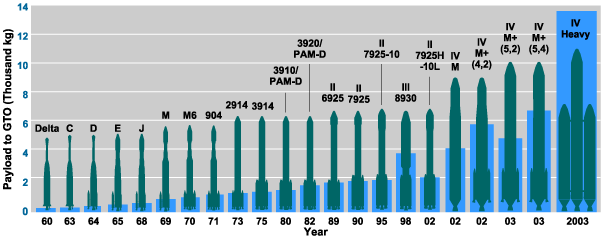 |
| Drawing: Boeing |
| Development of the Delta launch vehicle |
The basic Thor Delta, or Delta DM19, consisted of a Thor first stage with a second stage propelled by an Aerojet AJ-10-142 liquid fuelled motor and a third stage with an Allegheny Ballistics Laboratory X-248 Altair. The 27.75 m launch vehicle was capable of placing 275 kg into a low-Earth orbit. Between 13 May 1960 and 18 September 1962 12 were launched on which one was unsuccessful.
| Stage | Length | Diameter | Engine | Fuel | Thrust |
|---|---|---|---|---|---|
| 1 | 18.40 m | 2.44 m | 1 Rocketdyne MB-3-I | Lox/kerosene | 666,875 N |
| 2 | 5.40 m | 0.80 m | 1 Aerojet AJ-10-142 | N2O4/UDMH | 26,067 N |
| 3 | 1.53 m | 0.46 m | 1 ABL X-248 Altair | solid | 24,625 N |
Specifications for Thor Delta DM19
The Delta A or Delta DSV-3A was similar to the basic Thor Delta vehicle but had a Rocketdyne MB-3-II first stage motor as well as a second stage re-start capability. The length was 26.80 m and it had an orbiting capability of 320 kg into low-Earth orbit. Only two examples of this variant were launched on 2 October 1962 and 27 October 1962.
| Stage | Length | Diameter | Engine | Fuel | Thrust |
|---|---|---|---|---|---|
| 1 | 18.40 m | 2.44 m | 1 Rocketdyne MB-3-II | Lox/kerosene | 756,120 N |
| 2 | 5.40 m | 0.80 m | 1 Aerojet AJ-10-118 | N2O4/UDMH | 26,743 N |
| 3 | 1.80 m | 0.46 m | 1 ABL X-248 Altair | solid | 24,625 N |
Specifications for Delta DSV-3A
The next version, the Delta B or Delta DSV-3B was similar to the Delta DSV-3A, but with an improved guidance system and increased second stage burn time. Nine were launched between 13 December 1962 and 19 March 1964, of which one failed. The length was 26.80 m and the orbiting capability was 376 kg into low-Earth orbit.
 |
| Photo: Author's collection |
| Delta B |
| Stage | Length | Diameter | Engine | Fuel | Thrust |
|---|---|---|---|---|---|
| 1 | 18.40 m | 2.44 m | 1 Rocketdyne MB-3-II | Lox/kerosene | 756,120 N |
| 2 | 5.60 m | 0.80 m | 1 Aerojet AJ-10-118 | N2O4/UDMH | 26,743 N |
| 3 | 1.80 m | 0.46 m | 1 ABL X-248 Altair | solid | 24,625 N |
Specifications for Delta DSV-3B
For the Delta C or Delta DSV-3C the third stage engine was changed to an Altair X-258 solid fuelled motor. 10 examples were launched between 27 November 1963 and 8 March 1967, of which one failed. It had a launch capability of 410 kg into low-Earth orbit and a length of up to 31 m. There were also two Delta DSV-3C1 launch vehicles which differed in minor detail. It was flown on 25 May 1966 and 22 January 1969 and was capable of placing a 600 kg payload into low-Earth orbit.
 |
| Photo: Boeing |
| Delta C |
| Stage | Length | Diameter | Engine | Fuel | Thrust |
|---|---|---|---|---|---|
| 1 | 18.40 m | 2.44 m | 1 Rocketdyne MB-3-III | Lox/kerosene | 866,742 N |
| 2 | 5.60 m | 0.80 m | 1 Aerojet AJ-10-118 | N2O4/UDMH | 26,743 N |
| 3 | 2.50 m | 0.60 m | 1 ABL X-258 Altair | solid | 25,596 N |
Specifications for Delta DSV-3C
The Delta D or Delta DSV-3D, also known as Thrust Augmented Thor (TAT)-Delta was similar to the Delta C but carried three Thiokol TX-345-5 Castor solid fuelled motor as strap-on boosters. The version was first used only on 19 August 1964 and 6 April 1965, had a length of 28.30 m and was capable of placing 576 kg into a low-Earth orbit.
| Stage | Length | Diameter | Engine | Fuel | Thrust |
|---|---|---|---|---|---|
| 0 | --- | --- | 3 Thiokol Castor TX-345-5 | solid | 286,217 N each |
| 1 | 18.40 m | 2.44 m | 1 Rocketdyne MB-3-III | Lox/kerosene | 866,742 N |
| 2 | 5.60 m | 0.80 m | 1 Aerojet AJ-10-118 | N2O4/UDMH | 26,743 N |
| 3 | 2.50 m | 0.60 m | 1 ABL X-258 Altair | solid | 25,596 N |
Specifications for Delta DSV-3D
The Delta E or Delta DSV-3E, also referred to as Improved Thor Delta (TIAD), had the first stage and strap-ons of the Delta D and combined this with a larger diameter Aerojet AJ-10-118E second stage and an Allegheny Ballistic Laboratory X-258 third stage. It was first used in January 1968. The length was 29.20 m and the orbiting capability 735 kg into low-Earth orbit. It was used for six launches between 6 November 1965 and 20 April 1967.
| Stage | Length | Diameter | Engine | Fuel | Thrust |
|---|---|---|---|---|---|
| 0 | --- | --- | 3 Thiokol Castor TX-345-5 | solid | 286,217 N each |
| 1 | 18.40 m | 2.44 m | 1 Rocketdyne MB-3-III | Lox/kerosene | 866,742 N |
| 2 | 5.60 m | 1.42 m | 1 Aerojet AJ-10-118E | N2O4/UDMH | 35,099 N |
| 3 | 2.50 m | 0.60 m | 1 ABL X-258 Altair | solid | 25,596 N |
Specifications for Delta DSV-3E
The Delta DSV-3E1 version carried a third stage consisting of a United Technologies FW-4D solid fuelled motor which provided a thrust of 26,210 N. The length was 29.20 m and the orbiting capability 553 kg into low-Earth orbit. There were 17 flights, all of which successful, between 1 July 1966 and 1 April 1971. There was also a single flight of a Delta DSV-3E2 on 11 January 1967. This version differed in minor detail.
 |
| Photo: Boeing |
| Delta DSV-3E1 |
| Stage | Length | Diameter | Engine | Fuel | Thrust |
|---|---|---|---|---|---|
| 0 | --- | --- | 3 Thiokol Castor TX-345-5 | solid | 286,217 N each |
| 1 | 18.40 m | 2.44 m | 1 Rocketdyne MB-3-III | Lox/kerosene | 866,742 N |
| 2 | 5.60 m | 1.42 m | 1 Aerojet AJ-10-118E | N2O4/UDMH | 35,099 N |
| 3 | 1.50 m | 0.50 m | 1 United Tech FW-4D | solid | 26,210 N |
Specifications for Delta DSV-3E1
The Delta F was similar to the Delta DSV-3E but without the solid boosters. It was never built.
| Stage | Length | Diameter | Engine | Fuel | Thrust |
|---|---|---|---|---|---|
| 1 | 18.40 m | 2.44 m | 1 Rocketdyne MB-3-III | Lox/kerosene | 866,742 N |
| 2 | 5.60 m | 1.42 m | 1 Aerojet AJ-10-118E | N2O4/UDMH | 35,099 N |
| 3 | 1.50 m | 0.50 m | 1 United Tech FW-4D | solid | 26,210 N |
Specifications for Delta F
Two examples of the Delta G or Delta DSV-3G were flown on 11 December 1966 and 28 September 1967. It was a version of the Delta DSV-3E which did not carry a third stage. The length was up to 30 m and it was capable of placing a 507 kg payload into low-Earth orbit.
 |
| Photo: Author's collection |
| Delta G |
| Stage | Length | Diameter | Engine | Fuel | Thrust |
|---|---|---|---|---|---|
| 0 | --- | --- | 3 Thiokol Castor TX-345-5 | solid | 286,217 N each |
| 1 | 18.40 m | 2.44 m | 1 Rocketdyne MB-3-III | Lox/kerosene | 866,742 N |
| 2 | 5.60 m | 1.42 m | 1 Aerojet AJ-10-118E | N2O4/UDMH | 35,099 N |
Specifications for Delta DSV-3G
The Delta H was similar to the Delta DSV-3G but without the strap-on boosters. It was never built.
| Stage | Length | Diameter | Engine | Fuel | Thrust |
|---|---|---|---|---|---|
| 1 | 18.40 m | 2.44 m | 1 Rocketdyne MB-3-III | Lox/kerosene | 866,742 N |
| 2 | 5.60 m | 1.42 m | 1 Aerojet AJ-10-118E | N2O4/UDMH | 35,099 N |
Specifications for Delta H
The Delta J or Delta DSV-3J was flown only once, on 4 July 1968. It was similar to the Delta DSV-3E but with a Thiokol TE-364-3 solid fuelled motor as the third stage. It placed an 800 kg payload into a low-Earth orbit.
 |
| Photo: NASA |
| Delta J |
| Stage | Length | Diameter | Engine | Fuel | Thrust |
|---|---|---|---|---|---|
| 0 | --- | --- | 3 Thiokol Castor TX-345-5 | solid | 286,217 N each |
| 1 | 18.40 m | 2.44 m | 1 Rocketdyne MB-3-III | Lox/kerosene | 866,742 N |
| 2 | 5.60 m | 1.42 m | 1 Aerojet AJ-10-118E | N2O4/UDMH | 35,099 N |
| 3 | 0.80 m | 0.70 m | 1 Thiokol TE-364-3 | solid | 27,410 N |
Specifications for Delta DSV-3J
The Delta K was a proposed development that would use a cryogenic upper stage. It never proceeded beyond the design phase.
The Delta L or Delta DSV-3L used the Long Tank Thrust Augmented Thor (LTTAT) or Thorad, as the first stage. The vehicle had a length of 35.35 m and an orbiting capability of 998 kg into a low-Earth orbit. It was launched on two occasions, 27 August 1969 and 31 January 1972, of which the first flight failed. There was also a single flight of the Delta DSV-3L-II version on 3 February 1971. This version differed in minor detail.
| Stage | Length | Diameter | Engine | Fuel | Thrust |
|---|---|---|---|---|---|
| 0 | --- | --- | 3 Thiokol Castor TX-345-5 | solid | 286,217 N each |
| 1 | 21.40 m | 2.44 m | 1 Rocketdyne MB-3-III | Lox/kerosene | 866,742 N |
| 2 | 5.60 m | 1.42 m | 1 Aerojet AJ-10-118E | N2O4/UDMH | 35,099 N |
| 3 | 1.50 m | 0.50 m | 1 United Tech FW-4 | solid | 27,606 N |
Specifications for Delta DSV-3L
The Delta M or Delta DSV-3M was similar to the Delta DSV-3L but had a Thiokol TE-364-3 as the third stage. It was first used on 18 September 1968 and 13 flights were made until 13 March 1971, of which one failed. The last flight was also designated as Delta DSV-3M6, indicating six strap-on boosters. A version with nine strap-ons was not proceeded with. With a length of up to 34 m, the Delta DSV-3M was capable to place a 1293 kg payload into a low-Earth orbit.
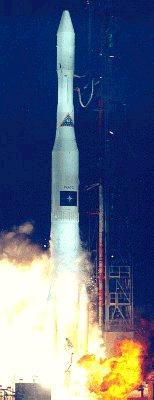 |
| Photo: Author's collection |
| Delta M |
| Stage | Length | Diameter | Engine | Fuel | Thrust |
|---|---|---|---|---|---|
| 0 | --- | --- | 3 Thiokol Castor TX-345-5 | solid | 286,217 N each |
| 1 | 21.40 m | 2.44 m | 1 Rocketdyne MB-3-III | Lox/kerosene | 866,742 N |
| 2 | 5.60 m | 1.42 m | 1 Aerojet AJ-10-118E | N2O4/UDMH | 35,099 N |
| 3 | 0.80 m | 0.70 m | 1 Thiokol TE-364-3 | solid | 27,410 N |
Specifications for Delta DSV-3M
The next version was the Delta N or Delta DSV-3N which was similar to the Delta L but deleted the third stage. With a length of up to 33 m, it was capable to place 900 kg into a low-Earth orbit. There were eight flights between 16 August 1968 and 21 October 1971. On the last two flights six strap-on boosters were carried and the launch vehicle was designated as Delta DSV-3N6. It had a payload capability of 1600 kg into low-Earth orbit. A version with nine strap-ons was not proceeded with.
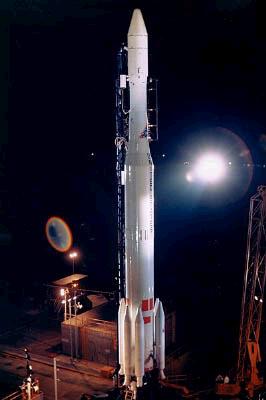 |
| Photo: Author's collection |
| Delta N |
| Stage | Length | Diameter | Engine | Fuel | Thrust |
|---|---|---|---|---|---|
| 0 | --- | --- | 3 Thiokol Castor TX-345-5 | solid | 286,217 N each |
| 1 | 21.40 m | 2.44 m | 1 Rocketdyne MB-3-III | Lox/kerosene | 866,742 N |
| 2 | 5.60 m | 1.42 m | 1 Aerojet AJ-10-118E | N2O4/UDMH | 35,099 N |
Specifications for Delta DSV-3N
Delta 300 and 900
In 1972 and 1973 a new designation system was used in which the first character following the name Delta indicated the number of Thiokol TX-354-5 strap-on boosters (3, 6 or 9), the second character indicated the second stage (with '0' meaning the Aerojet AJ-10-118F) whilst the third character indicated either that no third stage was carried ('0') or a Thiokol TE-364-4 ('1') third stage. The system was used only briefly and the only known designations are Delta 300 and Delta 900.
There were three flights of the Delta 300 from 15 October 1972 to 6 November 1973, of which one failed. The up to 34 m vehicle was capable to place a 360 kg payload into low-Earth orbit.
| Stage | Length | Diameter | Engine | Fuel | Thrust |
|---|---|---|---|---|---|
| 0 | --- | --- | 3 Thiokol Castor TX-345-5 | solid | 286,217 N each |
| 1 | 21.40 m | 2.44 m | 1 Rocketdyne MB-3-III | Lox/kerosene | 866,742 N |
| 2 | 6.30 m | 1.42 m | 1 Aerojet AJ-10-118F | N2O4/UDMH | 26,940 N |
Specifications for Delta 300
The Delta 900 had a length of up to 34 m and was capable of placing 820 kg into low-Earth orbit. Two flights were conducted on 23 July 1972 and 11 December 1972.
| Stage | Length | Diameter | Engine | Fuel | Thrust |
|---|---|---|---|---|---|
| 0 | --- | --- | 9 Thiokol Castor TX-345-5 | solid | 286,217 N each |
| 1 | 21.40 m | 2.44 m | 1 Rocketdyne MB-3-III | Lox/kerosene | 866,742 N |
| 2 | 6.30 m | 1.42 m | 1 Aerojet AJ-10-118F | N2O4/UDMH | 26,940 N |
Specifications for Delta 900
Delta beyond 1974 (incl. Delta 2)
By 1974 the Delta had evolved into a launch vehicle that had little relation to the original Thor missile and was marketed in a wide range of versions. To accommodate this, the launch vehicle designation system was modified (with later modifications as required), identifying the Delta launch vehicles by a four digit number which indicated the configuration of the launch vehicle.
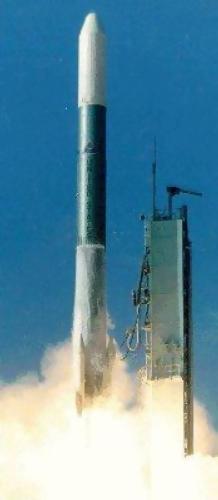 |
 |
 | ||
| Photos: Author's collection | Photo: Boeing | |||
| Delta 2310 | Delta 4925 | Delta 7925 (SB-3A) | ||
The first digit identifies the core stage and the strap-on boosters whilst the second digit indicates the number of strap-ons used. The third digit identifies the second stage whilst the final digit identifies the third stage. In the late 1990s occasionally additional digits were added to the designation indicating the diameter of the payload bay fairing in feet. There were 8', 9.5' and 10' fairings. The 10' fairing came in a 10 version (metal skin and stringer) a 10C (composite) ands a 10L (lengthened composite) version. In addition the letter H (for Heavy) has been added to the designations. First introduced in 2003, it indicated the use of larger strap-ons originally developed for the Delta 3 launch vehicle, providing a 13% increase in the payload capacity. In the popular press this version has been referred to as Delta 2 Heavy.
In 1982 McDonnell Douglas introduced the Delta 2 launch vehicle on a commercial basis. The configuration code was type 7925 and it provided a capability to place 1819 kg to a geostationary orbit. Delta 2 launch vehicles are sometimes shown with '2' as the first digit.
| Stage 1 engine | Length | Diam. | Fuel | Thrust | Strap-on engine | Fuel | Thrust | |
|---|---|---|---|---|---|---|---|---|
| 0 | 1 Rocketdyne MB-3-III | 22.43 m | 2.44 m | Lox/kerosene | 866,742 N | none | --- | --- |
| 1 | 1 Rocketdyne MB-3-III | 22.43 m | 2.44 m | Lox/kerosene | 866,742 N | Thiokol Castor 2 TX-354-4 | solid | 258,924 N |
| 2 | 1 Rocketdyne RS-27 | 22.43 m | 2.44 m | Lox/kerosene | 1,030,254 N | Thiokol Castor 2 TX-354-5 | solid | 286,217 N |
| 3 | 1 Rocketdyne RS-27 | 22.43 m | 2.44 m | Lox/kerosene | 1,030,254 N | Thiokol Castor 4 TX-526-2 | solid | 407,226 N |
| 4 | 1 Rocketdyne MB-3-III | 22.43 m | 2.44 m | Lox/kerosene | 866,742 N | Thiokol Castor 4A TX-780-1 | solid | 478,326 N |
| 5 | 1 Rocketdyne RS-27 | 22.43 m | 2.44 m | Lox/kerosene | 1,030,254 N | Thiokol Castor 4A TX-780-1 | solid | 478,326 N |
| 6 | 1 Rocketdyne RS-27A | 26.10 m | 2.44 m | Lox/kerosene | 1,032.039 N | Thiokol Castor 4A TX-780-1 | solid | 478,326 N |
| 7 | 1 Rocketdyne RS-27A | 26.10 m | 2.44 m | Lox/kerosene | 1,032.039 N | Hercules GM 40 | solid | 492,948 N |
| 8 | 1 Rocketdyne RS-27A | 26.10 m | 2.44 m | Lox/kerosene | 1,032.039 N | Hercules GM 46 | solid | 492,948 N |
First digit - first stage and strap-ons
| Length | Diameter | Engine | Fuel | Thrust | |
|---|---|---|---|---|---|
| 0 | 6.30 m | 1.42 m | 1 Aerojet AJ-10-118F | N2O4/UDMH | 26,940 N |
| 1 | 6.00 m | 1.42 m | 1 TRW TR-201 | N2O4/Aerozine | 41,925 N |
| 2 | 5.90 m | 1.70 m | 1 Aerojet AJ-10-118K (Delta K) * | N2O4/Aerozine | 43,641 N |
| 3 | 8.80 m | 4.40 m | 1 P&W RL10B-2 | Lox/LH | 110,054 N |
| 4 | 8.80 m | 4.40 m | 1 P&W RL10B-2 with 4 m tankage | Lox/LH | 110,054 N |
| 5 | 8.80 m | 4.40 m | 1 P&W RL10B-2 with 5 m tankage | Lox/LH | 110,054 N |
Third digit - second stage
(* not to be confused with the unbuilt "Delta K" launch vehicle)
| Length | Diameter | Engine | Fuel | Thrust | |
|---|---|---|---|---|---|
| 0 | No third stage | ||||
| 1 | 1.83 m | 0.97 m | 1 Thiokol TE-364-3 | solid | 42,000 N |
| 2 | 1.83 m | 0.97 m | 1 Thiokol TE-364-4 | solid | 67,000 N |
| 3 | 1.83 m | 0.97 m | 1 Thiokol TE-364-3 | solid | 42,000 N |
| 4 | 1.83 m | 0.97 m | 1 Thiokol TE-364-4 | solid | 67,000 N |
| 5 | 2.00 m | 1.20 m | 1 Thiokol Star 48B (PAM-D) | solid | 67,158 N |
| 6 | 1.70 m | 0.90 m | 1 Thiokol Star 37FM | solid | 47,260 N |
Fourth digit - third stage
The utilization of these launch vehicles, which had a length ranging from 34 m to 38 m, depending on the configuration, is shown in the following table.
| Delta | Cap low Earth | 1st flight | Last flight | Flights | Failures |
|---|---|---|---|---|---|
| Delta 1600 | * | 28 October 1973 | 28 October 1973 | 1 | 0 |
| Delta 1604 | * | 23 September 1972 | 23 September 1972 | 1 | 0 |
| Delta 1900 | 1800 kg | 16 December 1973 | 16 December 1973 | 1 | 0 |
| Delta 1913 | * | 10 June 1973 | 10 June 1973 | 1 | 0 |
| Delta 1914 | * | 10 November 1972 | 20 April 1973 | 2 | 0 |
| Delta 2310 | * | 15 November 1974 | 6 October 1981 | 3 | 0 |
| Delta 2313 | * | 19 January 1974 | 25 August 1977 | 3 | 0 |
| Delta 2910 | 1887 kg | 22 January 1975 | 24 October 1978 | 8 | 0 |
| Delta 2913 | * | 9 August 1975 | 4 May 1976 | 2 | 0 |
| Delta 2914 | * | 13 April 1975 | 10 August 1979 | 30 | 0 |
| Delta 3910 | 2494 kg | 14 February 1980 | 8 February 1988 | 11 | 0 |
| Delta 3913 | * | 3 August 1981 | 3 August 1981 | 1 | 0 |
| Delta 3914 | * | 13 December 1975 | 3 May 1986 | 12 | 1 |
| Delta 3920 | 3452 kg | 16 July 1982 | 24 March 1989 | 9 | 0 |
| Delta 3924 | * | 28 October 1982 | 26 February 1987 | 5 | 0 |
| Delta 4925 | * | 27 August 1989 | 12 June 1990 | 2 | 0 |
| Delta 5920 | 3849 kg | 18 November 1989 | 18 November 1989 | 1 | 0 |
| Delta 6920 | 3983 kg | 1 June 1990 | 7 June 1992 | 2 | 0 |
| Delta 6925 | * | 14 February 1989 | 24 July 1992 | 15 | 0 |
| Delta 7025 | * | 18 May 2001 | 18 May 2001 | 1 | 0 |
| Delta 7320 | 2865 kg | 24 June 1999 | 20 May 2005 | 6 | 0 |
| Delta 7326 | * | 24 October 1998 | 8 August 2001 | 3 | 0 |
| Delta 7420 | 3094 kg | 14 February 1998 | 8 February 2000 | 7 | 0 |
| Delta 7425 | * | 11 December 1998 | 3 July 2002 | 4 | 0 |
| Delta 7426 | * | 7 February 1999 | 7 February 1999 | 1 | 0 |
| Delta 7920 | 5089 kg | 4 November 1995 | 14 July 2004 | 23 | 0 |
| Delta 7925 | 5815 kg | 26 November 1990 | 26 September 2005 | 60 | 1 |
Delta launch vehicle configurations (updated to 31 December 2005)
(* = not used for low-Earth orbit launches)
Delta 2 Designations
Sometime in 2006 Boeing decided to redesignated the Delta 2 launch vehicle from Delta 7xxx to Delta 2xxx. The following table lists the old and new designations of the various known versions, as well as a summary of the composition of these launch vehicles.
| Old designation | New designation | Strap-ons | EELT core | 2nd stage | Upper stage | Fairing diameter |
|---|---|---|---|---|---|---|
| 7320-10 | 2320-10 | 3 GEM-40 | RS-27A | Delta K | --- | 10' |
| 7326-9.5 | 2326-9.5 | 3 GEM-40 | RS-27A | Delta K | Star 37FM | 9.5' |
| 7420-10C | 2420-10C | 4 GEM-40 | RS-27A | Delta K | --- | 10' composite |
| 7425-9.5 | 2425-9.5 | 4 GEM-40 | RS-27A | Delta K | Star 48B | 9.5' |
| 7425-10 | 2425-10 | 4 GEM-40 | RS-27A | Delta K | Star 48B | 10' |
| 7426-9.5 | 2426-9.5 | 4 GEM-40 | RS-27A | Delta K | Star 37FM | 9.5' |
| 7920-8 | 2920-8 | 9 GEM-40 | RS-27A | Delta K | --- | 8' |
| 7920-10 | 2920-10 | 9 GEM-40 | RS-27A | Delta K | --- | 10' |
| 7920-10C | 2920-10C | 9 GEM-40 | RS-27A | Delta K | --- | 10' composite |
| 7920-10L | 2920-10L | 9 GEM-40 | RS-27A | Delta K | --- | 10' long |
| 7925-8 | 2925-8 | 9 GEM-40 | RS-27A | Delta K | Star 48B | 8' |
| 7925-9.5 | 2925-9.5 | 9 GEM-40 | RS-27A | Delta K | Star 48B | 9.5' |
| 7925-10 | 2925-10 | 9 GEM-40 | RS-27A | Delta K | Star 48B | 10' |
| 7925H | 2925H | 9 GEM-46 | RS-27A | Delta K | Star | n.a. |
Current Delta 2 launch vehicle configurations
Delta 3
In 1995 McDonnell Douglas proposed to enlarge the family of Delta launch vehicle with the introduction of the Delta 3.
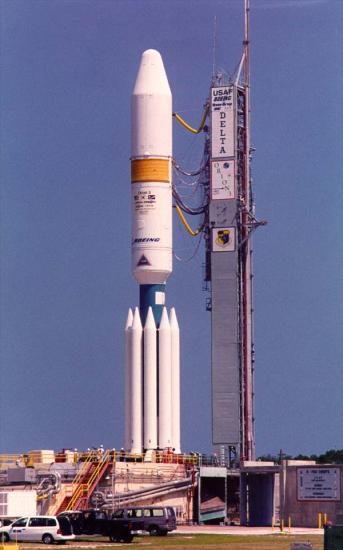 |
| Photo: Boeing |
| Delta 3 |
The Delta 3 used the Delta 2 first stage in combination with a cryogenic upper stage powered by a Pratt & Whitney RL10B-2 engine. The basic version had nine strap-on solid fuelled boosters built by Alliant Techsystems of which six were ignited during the launch and another three during the flight. In this configuration the launch vehicle had a launch capability of 8292 kg into low-Earth orbit. It had a length of 39.08 m. Other versions considered, but not built, carried three or six solid fuelled strap-on boosters.
Up to 31 December 2002 the Delta 3, also referred to as Delta 8930, was launched three times between 26 August 1998 and 23 August 2002 of which one failed whilst the other two launches provided unacceptable results. A number of vehicles were built to meet orders for 18 launches but, with the results and the Delta 4 coming into use, the remaining Delta 3s are expected to be scrapped and used for spares.
| Stage | Length | Diameter | Engine | Fuel | Thrust |
|---|---|---|---|---|---|
| 0 | --- | --- | 9 Alliant Tech S GEM-46 | solid | 628,334 N each |
| 1 | 20.03 m | 2.44 m | 1 Boeing Rocketdyne RS-27A | Lox/kerosene | 1,085,831 N |
| 2 | 8.80 m | 4.40 m | 1 P&W RL10B-2 | Lox/LH | 110,054 N |
Specifications for Delta 3
Delta 4
The Delta 4 was Boeing's successful response to the US Air Force's Evolved Expendable Launch Vehicle (EELV) programme. Initially intended also for the commercial market, the weakness of that market made Boeing decide to concentrate on the military market only. In the Delta 4 the first stage of the Delta 3 was replaced with a new booster, driven by a Boeing Rocketdyne RS-68 with a thrust of 2,891,000 N. To this common core with a length of 37.92 m and a diameter of 4.85 m, a second stage with a length of 12.00 m and a diameter of 4.00 m and powered by 1 Pratt & Whitney RL-10B engine developing a thrust of 110,054 N is added. The launch vehicle is completed with a variety of boosters and payload fairings.
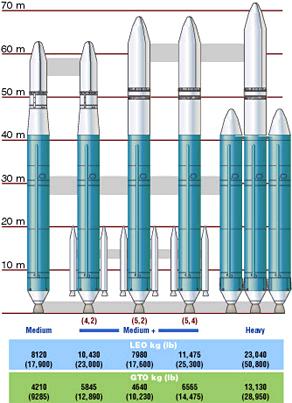 |
| Image: Boeing |
| Delta 4 family |
The Delta 4 Medium version will have a 4 m fairing and will be capable to place up to 4200 kg into GTO. The 4.2 version will have a 4 m fairing as well as 2 Alliant Tech Systems GEM 60 strap-on boosters with a thrust of 826,583 N each, and a capacity of 8182 kg into low-Earth orbit. The 5.2 and 5.4 versions will have a 5 m fairing and two or four GEM 60 strap-on boosters, providing up to 11,475 kg into low-Earth orbit. The length will be up to 66.20 m. The first flight was on 20 November 2002 and to 31 December 2007 6 launches took place.
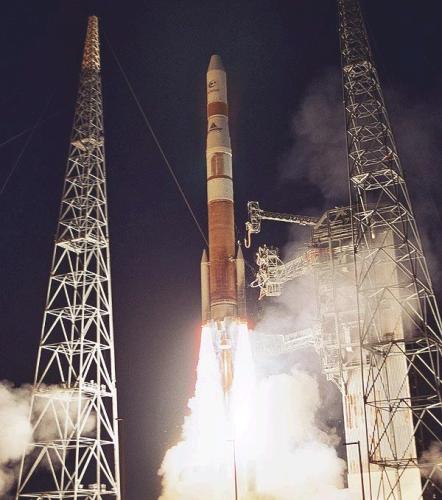 |
| Photo: Boeing |
| Delta 4 Medium |
The Delta 4 Heavy is a 70.70 m vehicle, in which the strap-on boosters are the same as the core stage, providing, with a 5 m fairing, a capacity of 23,040 kg into low-Earth orbit. The first launch of this vehicle took place on 21 December 2004. This was a test launch and a premature shutdown of the first stage prevented the test payload from achieving the correct orbit. The second flight took place on 11 November 2007.
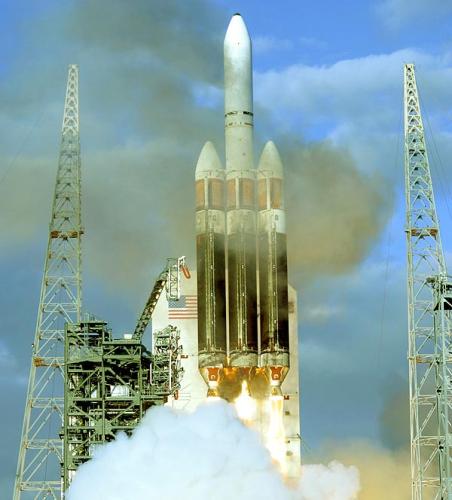 |
| Photo: Boeing |
| Delta 4 Heavy |
The proposed Delta 4 Small version will consist of the core and the upper stage and, with a 3 m fairing, will be capable of placing 2200 kg into a geostationary transfer orbit (GTO). The total length will be 59 m. To date no flights were undertaken.
Delta 5
The proposed Delta 5.2 and Delta 5.4 Medium versions will have a 5 m fairing and two or four GEM 60 strap-on boosters, providing up to 11475 kg into low orbit. The length is up to 66.20 m. These versions have not yet flown.
Back to Directory of U.S. Military Rockets and Missiles, Appendix 3
Last Updated: 18 January 2008